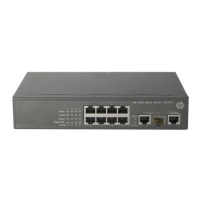• Policy
• Other criteria
NOTE:
• The A3100 v2 EI Switch Series supports port-based VLAN, MAC-based VLAN, and protocol-based
VLAN. The A3100 v2 SI Switch Series supports port-based VLAN and MAC-based VLAN.
• The port-based VLAN implementation is the basis of all other VLAN implementations. To use any other
VLAN implementations, you must configure port-based VLAN settings.
• You can configure all these types of VLANs on a port at the same time. When the switch is determinin
which VLAN a packet that passes through the port should be assigned to, it looks up the VLANs in the
default order of MAC-based VLAN, protocol-based VLAN, and port-based VLAN.
Configuring basic VLAN settings
Follow these steps to configure basic VLAN settings:
To do… Use the command… Remarks
Enter system view system-view —
Create VLANs
vlan { vlan-id1 [ to vlan-id2 ] |
all }
Optional
Use this command to create VLANs in bulk.
Enter VLAN view vlan vlan-id
Required
If the specified VLAN does not exist, this
command creates the VLAN first.
By default, only the default VLAN (VLAN 1)
exists in the system.
Configure a name for the
current VLAN
name text
Optional
By default, the name of a VLAN is its VLAN
ID (VLAN 0001, for example).
Configure the description of
the current VLAN
description text
Optional
VLAN ID is used by default (VLAN 0001,
for example).
NOTE:
• As the default VLAN, VLAN 1 cannot be created or removed.
• You cannot manually create or remove VLANs reserved for special purposes.
• You cannot remove dynamic VLANs by using the undo vlan command.
• You cannot remove a VLAN with a QoS policy applied.
• You cannot remove a VLAN that is operating as a remote probe VLAN for remote port mirroring by
using the undo vlan command. To do that, remove the remote probe VLAN configuration from it first.
Configuring basic settings of a VLAN interface
For hosts of different VLANs to communicate, you must use a router or Layer 3 switch to perform layer 3
forwarding. You use VLAN interfaces to achieve this.
96

